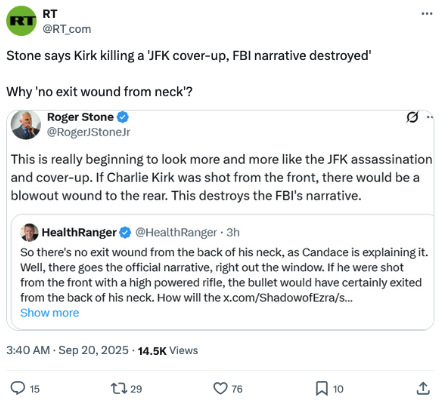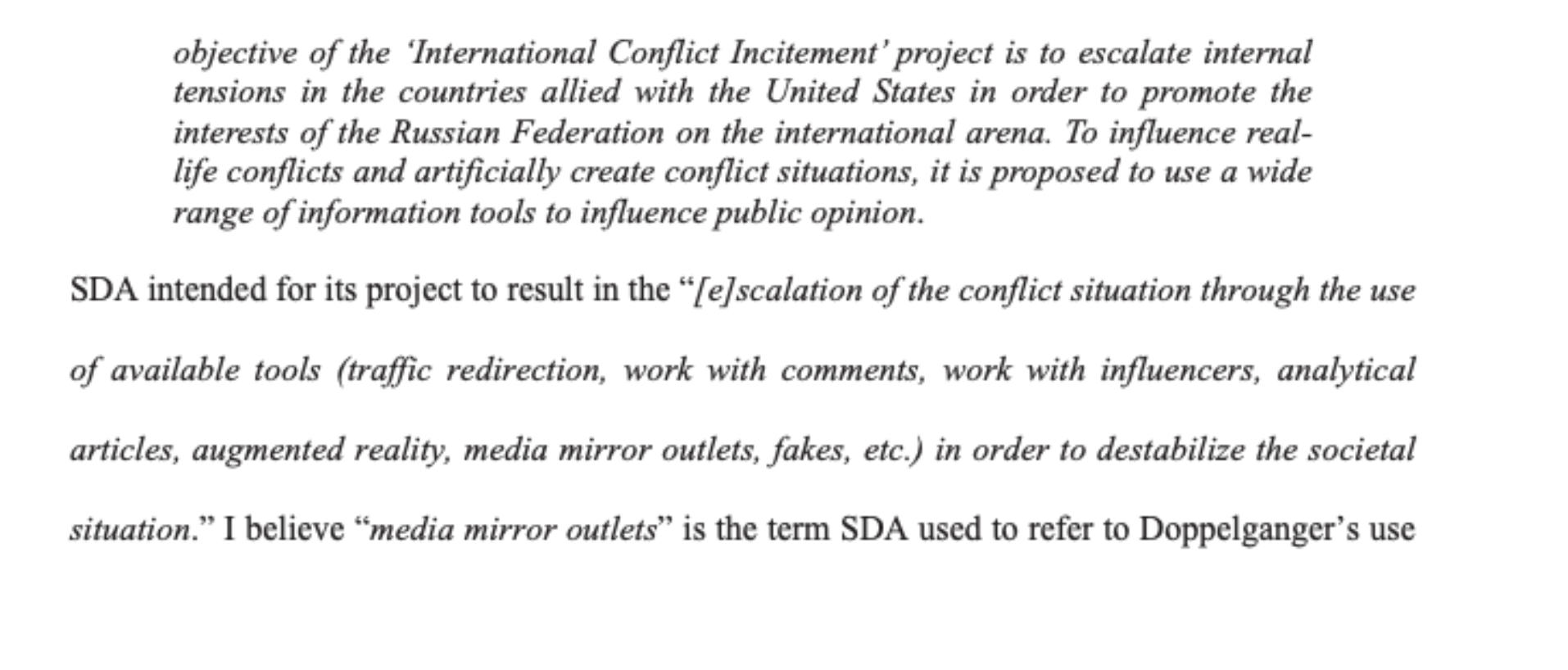Incident Update 1︱Kremlin Doppelgänger Tactics and the Exploitation of the Charlie Kirk Murder
Author(s) & Organization
Marcus Kolga, DisinfoWatch
Layla Mashkoor, DFRLab
Meredith Furbish, DFRLab
Key takeaways
Strong evidence of information warfare tactics employed by Russia: With high confidence, it appears that though the Kremlin has exploited Kirk’s death as part of its information warfare strategy, employing tactics outlined in the FBI’s Doppelgänger affidavit.
Amplified claims were mostly conspiratorial in nature: Dominant claims included making links to historic U.S. assassinations, emphasizing that the American left celebrated his death, and links tying the killing to Ukraine or Israel.
Russian response aimed to polarize and delegitimize: Information operations involved monitoring foreign information spaces to identify emerging issues most likely to fracture society, and then deploying a suite of tactics to circulate and amplify false or contradictory narratives and conspiracies, with the aim to deepen divisions and polarization.
Introduction
Context
In September 2024, the FBI released an affidavit detailing Russia’s Doppelgänger campaign, an information operation that deployed networks of counterfeit URLs mimicking major Western media outlets in order to deceive social media users worldwide. The affidavit included classified documents from the Russian Presidential Administration that outlined the Kremlin’s strategic objectives and information warfare and influence operations tactics, techniques and procedures. These materials, consisting of strategic plans and minutes from meetings chaired by Vladimir Putin’s senior advisors, directed three Russian communications firms, Social Design Agency (SDA), Structura National Technology (Structura), and ANO Dialog, to conduct influence operations abroad.
The documents instructed these firms to closely monitor Western information and political environments and to identify events and issues with the greatest potential to divide and polarize democratic societies. These efforts formed part of the Kremlin’s “International Conflict Incitement” project, whose stated goal was to “influence real-life conflicts and artificially create conflict situations.” Operational tactics involve saturating the information environment with narratives designed to confuse and divide audiences through methods such as “traffic redirection, coordinated comment campaigns, engagement with influencers, analytical articles, augmented reality, media mirror outlets, fake content, and more,” all with the ultimate objective of undermining societal cohesion. Contractors and agents were further directed to disseminate “false narratives,” “fabricated videos, documents, and recorded conversations,” as well as “social media commentary” and “quotes, both real and invented, from public figures” – in essence, to saturate, confuse and exploit the event.
These materials illustrate in remarkable detail the Kremlin’s systematic approach to operationalizing information warfare. While the Russian Foreign Ministry explicitly denies trying to exploit the murder, the strategies and tactics identified in the FBI investigation were clearly reflected in the rapid exploitation of Charlie Kirk’s murder in September 2025.
Screenshot of the FBI Doppelganger Affidavit
Key questions
To assess the nature of Russia's involvement following Kirk’s death, we seek to address three questions:
Did Russia apply information warfare tactics in the wake of Charlie Kirk’s assassination?
What claims emerged from Russian state-sponsored media following the event?
What is Russia trying to achieve?
1. Did Russia apply information warfare tactics in the wake of Charlie Kirk’s assassination?
Following Kirk’s death, Russian state media and aligned channels mobilized almost immediately. Explained in more detail in question 2, state outlets seeded politicized and conspiratorial frames that ranged from blaming Ukraine to drawing on U.S. culture-war narratives. This reflects the operational features and tactics described in the FBI’s Doppelgänger affidavit, which focuses on identifying and exploiting issues with the greatest potential to divide Western societies.
Rapid saturation. A flood of stories and posts ensured that Russian narratives entered circulation before facts were established.
Plural and inconsistent storylines. Some narratives connected the murder to U.S. support for Ukraine. Others invoked identity politics or anti-Zionist tropes. Consistency was secondary to the effect of fragmentation.
Amplification. Russian state-controlled channels were monitoring the US information space and were selectively amplifying content with the greatest potential to intensify polarization.
The pattern mirrored the doctrine described in the FBI affidavit: to saturate the information environment, confuse audiences, and exploit tragedy to deepen social divisions.





Examples of screenshots demonstrating Russian attempts to polarize and legitimize the killing
2. What claims emerged from Russian state-sponsored media following Kirk’s death?
In-depth investigation of Russian state-media outlets, Sputnik and Russia Today (RT), revealed a strong push of conspiratorial claims. While Sputnik devoted only a small amount of coverage to Kirk’s assassination, they leaned heavily on narratives particularly linking the event to other famous American assassinations (John F. and Robert F. Kennedy Sr., Martin Luther King, and Malcolm X). This story was based on an interview with a former FSB agent, who promoted common conspiracy tropes like sleeper agents and the supposed deep state controlling US security forces.
In contrast, RT’s X account seized the incident almost immediately, and the focus was disproportionately high in comparison to other subjects. The main claim in their coverage was that the American political left was celebrating Kirk’s death (see here and here). While the assassination was widely condemned across the American political spectrum, over a quarter of RT posts about Kirk in the 24 hours after his death were about unsympathetic or celebratory reactions to his death. Just under 20 percent of posts were about sympathetic responses or grief, but these were almost exclusively the reactions of right-wing figures, which appears to be an attempt to create the impression of a partisan split in attitudes to Kirk’s death.
More broadly, RT and other news sources suggested the assassination was connected to Ukraine and, also, Israel. Discussions about Ukraine, aimed at fabricating a connection between the assailant and Ukraine or those supportive of Ukraine. These narratives included posts that emphasized Kirk’s previous remarks regarding Ukraine, presenting them as a possible motive. Former Russian President Dmitry Medvedev explicitly accused Ukrainians in a tweet posted the day of the murder. Concurrently, other content sought to exploit cultural fault lines by advancing claims of a conspiracy involving a so-called “transgender terrorist cell.” Discussions about Israel were more subtle. Posts implicated Israeli involvement through imagery like the Star of David or Israeli flags rather than explicit mention, prompting audiences to respond with criticism of Israel and antisemitism, including conspiratorial claims linking Israel to historical assassinations.
3. What is Russia trying to achieve?
The tactics used serve broader strategic objectives. Russian information operations are part of a coherent strategy aimed at achieving three interrelated goals.
Polarization of Western societies. Moscow benefits when democratic states are internally divided. By introducing conspiracy, grievance, and culture-war framing into the Kirk case, Russian media sharpened political and social cleavages in the United States.
Delegitimization of democratic institutions. Narratives that suggested authorities were concealing information or that media coverage was unreliable aligned with Russia’s long-standing goal of undermining confidence in democratic governance and independent journalism.
Erosion of support for Ukraine. By associating Kirk’s murder with U.S. policy toward Ukraine, and speculating about Kyiv’s involvement, Russia advanced its strategic priority of weakening Western resolve to sustain military and political support for Ukraine.
RT’s coverage illustrates these objectives. It framed the killing as an “assault on free speech,” recycled Kremlin-friendly claims about Ukraine, and amplified identity-based grievances. This was not conventional reporting but a deliberate attempt to instrumentalize the event for political effect.
Recommendations
The Kremlin’s exploitation of the Kirk case followed the same operating logic established in its Doppelgänger program: industrial-scale disinformation measured by reach rather than accuracy. By pushing contradictory narratives and ensuring their rapid penetration into public debate, Russia converted a domestic American tragedy into a tool for advancing its foreign policy aims. Canada, like other democracies, was not immune to these narratives.
The documents exposed in the FBI affidavit provide clear insight into Russia’s objectives and methods. Governments, media, and civil society should have anticipated that Moscow would seize on the Kirk incident, just as it will exploit future crises and sensitive issues. The Doppelgänger materials should be treated as a roadmap for building defences that reinforce democratic information environments and societal resilience against the manipulation of tragedy.
Recognizing this doctrine and preparing accordingly is essential if democracies are to blunt the impact of future Russian information manipulation campaigns.

